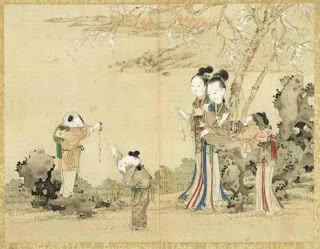Lin Lan Calligraphy and Painting: 100 Episodes of Ancient Customs in Chinese Paintings (Episode 1: Burning Firecrackers)
Most of the traditional Chinese New Year customs have been followed for hundreds to thousands of years. Despite historical changes and regional differences, these customs have not changed much in their main content and form.
The New Year's Day is an ancient traditional festival in our country. Various folklore events compete to show their unique style on this day.
Song Dynasty Wang Anshi's "Yuan Ri" described the scene of the New Year. "The sound of firecrackers will eliminate one year old, and the spring breeze will bring warmth to Tusu.
Thousands of families always exchange new peaches for old symbols." The poem contains Three Spring Festival customs: setting off firecrackers, drinking Tusu wine, and changing peach charms.
Chinese paintings are full of Chinese people's grandest festivals, and Chinese brush calligraphy works can be seen everywhere in Chinese paintings, which brings blessings to the Spring Festival!
Setting off firecrackers has a long history in our country. Folklorists believe that firecrackers originated from the "Boom Sacrifice" activities that existed in the pre-Qin period. "Blasting sacrifice" is a religious act of burning wood to worship the gods and drive away evil spirits.
From "The Book of Songs·Xiaoya·Ting Liao", you can read the verses like "Ting Liao is clear and clear". Ting Liao, the ancients tied bamboo, grass, or hemp stalks together and set it off to make the night shine like daylight,
which has the effect of lighting and exorcising evil spirits. This may be the embryonic form of firecrackers in our country, and it has been more than two thousand years ago.
Regarding firecrackers, many books have already introduced them in detail. They were originally used by people to avoid evil and dispel disasters.
"Jing Chu Sui Shi Ji" contains: "The first day of the first lunar month is the day of the three yuan, and the spring and autumn is the day of the end.
The roosters rise before the firecrackers in front of the court to ward off the mandrill and evil ghosts."
It seems to follow the saying in the Western Han Dongfang Shuo's "Sutra of Miracles and Western Wilderness": There are people in the deep mountains of the West.
See people stay overnight, and follow the fire at night to broil shrimps and crabs. Waiting for people is not there, but stealing salt to eat shrimps and crabs.
The name is Shan Qian, and the sound is called himself. People taste the bamboo in the fire and burst out, and they are all shocked.
It is chilling and hot. Although this human shape changes, it is also a ghost and the like, which are all found in the mountains today.
However, with the gradual fading of backwardness, setting off firecrackers has seldom contained the element of exorcising ghosts, but merely added a joyous atmosphere to the festival.
With the advent of modern civilization, many large, medium and small cities have begun to ban the burning of firecrackers on festivals.
There is a saying in the Chinese folks that "open the door with firecrackers", that is, when the new year arrives, the first thing that every household opens the door is to set off firecrackers, saying goodbye to the old with the sound of crackling firecrackers.
And the setting off of firecrackers in the New Year only began to prevail in the Tang Dynasty. The "Yuezhou Shousui" written by the poet Zhang of the Tang Dynasty wrote: "The peach branches are worthy of evil, and the bamboo fire is good for sleep."
The prime minister was awakened in his sleep and even claimed praise. This shows his excitement and joy on New Year's Eve.
Xue Neng also chanted in "New Year's Eve Composition": "Lan Weiwei, this night, bamboo fires and neighbors." In other words, setting off firecrackers also has the effect of harmonizing neighbors' feelings.
At this time, the widely popular "firecrackers" still ignite and burn real bamboo, also called "blasting rods", and there is no gunpowder involved. The phenomenon of burning "year-old fire" that can still be seen in modern villages is this legacy.
Setting off firecrackers is a kind of entertainment in Chinese festivals, which can bring joy and good fortune to people.
According to historical records, the earliest firecrackers were torches made of combustibles such as bamboo poles.
Because bamboo is abundant in the south of our country, this custom first became popular from the south.
When the bamboo burns, the air in the bamboo joints expands, causing the bamboo cavity to burst, making a crackling sound, and the name of the firecracker is derived from this.
Around the time of the Tang Dynasty, people put gunpowder in a bamboo tube and ignited it. People in the Song Dynasty have generally used paper rolls with gunpowder in them instead of bamboo tubes,
which is now the firecracker. After that, setting off fireworks and firecrackers has become a must-have program for Chinese New Year, and it is still thriving today.






















No comments: